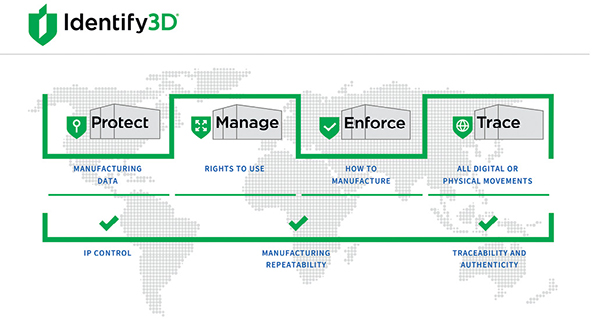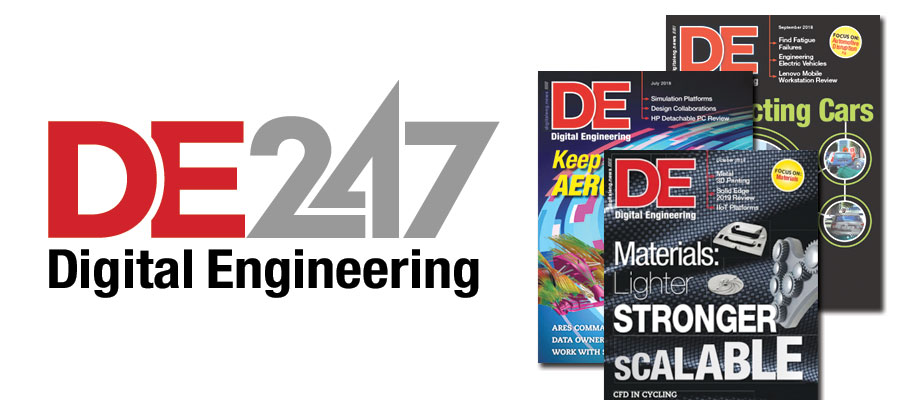This article was originally published In digital engineering
3D Printing Permissions
Coming soon to an additive manufacturing shop near you: digital rights management for 3D printing
OK, I admit it: I once ripped my entire “Star Wars” DVD collection so I could watch it on my iPad. There was a long flight coming up and a certain well-known media store wanted 100 bucks for the download. Please don’t tell anyone though; I’ve since learned that I violated Title I of the Digital Millennium Copyright Act. 17 U.S.C. 1201 and could face a $500,000 penalty and up to 5 years of imprisonment.
I get it. Intellectual property theft is a serious offense, but really, paying for “The Phantom Menace” a second time would be adding insult to injury. All kidding aside, digital rights management (DRM) is an important concept, not only for musicians and movie producers, but also for companies that develop products using additive manufacturing.
Navigating the Ecosystem
DRM is a broad, end-to-end strategy, one that promises to help control product designs and documentation as well as part quality and equipment use, explains Koen Neutjens, business development manager at Belgium-based Materialise NV. Perhaps more importantly, it assures that people can only print parts on authorized machinery at authorized facilities.
To a machine shop or fabricator, it might seem silly to ask for permission before manufacturing a part, but for those who 3D print parts, the concept isn’t all that far-fetched. The chances are good that the copy machine in the front office is at least capable of asking for a username and password, ensuring that employees aren’t using the equipment for non-business needs, and that costs get allocated to the correct department.
There’s one catch. Unlike media-centric DRM, where encryption or file encoding mechanisms are all that’s needed to curtail illegal copying and distribution activities, additive DRM requires the support of everyone who touches the 3D printing process.
“That means the part designers, the 3D printing software developers, the end users and their managers, and especially the machine builders,” says Neutjens. “Without their cooperation, DRM will be difficult to enforce.”
Despite the challenges, Materialise is moving full steam ahead. “We find that our customers’ understanding and requirements for DRM are application-driven and diverse,” he explains. “Today, with our additive manufacturing software suite, we offer our customers file protection for targeted applications, within a secure digital manufacturing environment. For these application-specific workflows, DRM-related “metadata” is incorporated into a protected file before being transferred to a 3D printer. DRM will become an integral part of the global distributed manufacturing networks that our customers are creating.”
Delivering Data Integrity
Some say it takes a village to raise a child—with DRM, it’s no different. That’s why Materialise works with its partners to establish a true end-to-end, secure 3D printing manufacturing process, where part designs are processed on an approved machine, using the approved build file and parameters, and where they can only be printed as many times as is specified in the file. Yet Neutjens is quick to point out that another element is needed: a third-party DRM provider to apply the necessary access rights and to encrypt the files.
Joe Inkenbrandt is delivering that third party, even though he doesn’t care for the term DRM. The founder and CEO of Identify3D says traditional DRM is about protecting revenue streams, whereas additive DRM embraces more than that.
“The primary goal is to make certain that this complex manufacturing technology is applied correctly, and that consumers receive what they paid for—namely, good parts,” he says.

It works by containerizing all of the relevant data, Inkenbrandt says. A company such as GE, Boeing or anyone that needs tight product control—including where and how they’re manufactured—uses the Identify3D solution to specify what assets and processes should be tracked. This metadata is then encrypted together with the relevant files and placed within a secure digital container. Only someone with the correct license key can access the data within this container.
Like Materialise, Identify3D is partnering with machine tool builders. Yet Inkenbrandt says DRM goes much deeper. It might pull raw material suppliers into the loop, as well as quality control providers, design and manufacturing software developers, post-processing equipment manufacturers and especially service bureaus. All must be part of the additive DRM ecosystem if this burgeoning technology is to be made as robust as possible.
Herding Cats
And yet, DRM will never be hackproof. “Any security expert will tell you that nothing’s unbreakable, period,” Inkenbrandt says. “Whether it’s fine jewelry or a product design, pour enough money and effort into stealing something and you’ll ultimately be successful. It’s our job to analyze the threats and understand where the attacks are going to come from, and then safeguard against those threats to the level that theft is no longer economically feasible.”
So why should organizations bother? If the manufacturing industry will always have a certain flavor of the Wild West, one might argue that DRM isn’t worth the effort. Jonathan Scott, chief architect at consulting firm Razorleaf Corporation, disagrees, suggesting that DRM shares many of the same attributes as a product lifecycle management (PLM) system, and that both are becoming invaluable tools in controlling what could be chaos.
“PLM and DRM are like partners in the perfect marriage,” he says. “Where PLM does a great job of managing product definition from cradle to grave, DRM protects some of the different phases of that physical product’s lifecycle.”
Scott adds that DRM shares some similarities to a manufacturing execution system (MES), in that it controls various elements of the manufacturing process, albeit more securely.
The question becomes: With all these different systems available, shouldn’t additive manufacturing as a whole run like the proverbial well-oiled machine? Unfortunately, we’re not there yet. Most of the additive shops that Scott talks to have none of these systems, though interest is growing.
“Companies are beginning to realize the power of additive manufacturing, and a number of them have recognized that PLM is every bit as important here as it is with traditional processes—in some ways, even more so,” Scott says.
“The design potential and part complexity are far greater with additive, never mind the fact that you’re determining many of the material properties as you build the part—the possibility of developing a truly unique product design is significant,” Scott continues. “So whether it’s your part design or the customer’s, what happens when they ask you for the entire set of build parameters when you deliver the finished part? There’s a great deal of intellectual property involved—are you just going to give it away? That’s where DRM becomes a game-changer.”
![]()
